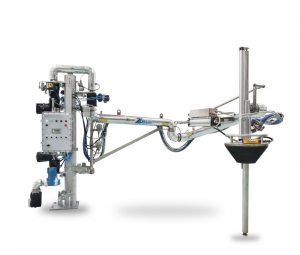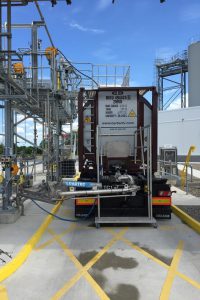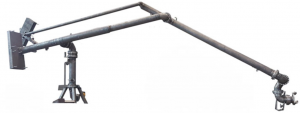Product Loading Arms

Loading arm systems allow the transfer of gas or liquefied gas from one tank to another through a pipe system. When transferring gas, you will need both a bottom and top loading arm. Whether the application involves tank trucks, railcars, drums or totes, and the moving of petroleum products, liquified gases, asphalt, solvents or hazardous/corrosive chemicals.
Top & Bottom Loading Arms
Both types of loading arms are typically made of 3 pipes – respectively called inner arm, outer arm and drop pipe. The size can be from 2” to 6”. These 3 pipes are connected by swivel joints. Swivel joints are required to provide the flexibility needed. The loading arm unfolds to get the required working envelope to load or unload the tanker, and the reverse is to retract or get a minimal space for parking or storage. Both types of loading arms may be mounted on a column or via a plate to an existing wall. Balancing is needed due to the weight of the steel piping. Balancing of the arm is made by counterweight or by a spring balance cylinder.
Top Loading Arm

Top loading arms are used to load or unload road or rail tankers. Loading or unloading is done through the manhole on the top of the tanker. Depending on the nature of the product (not dangerous, without any toxic vapours…), the connection may be “open”, this means that the manhole is not sealed. A “Semi-Closed” connection can be made by a cone on the manhole of the tanker. A “Closed” connection is required for all dangerous and toxic products. This connection is made by a flange to the top of the tanker. A cone can be equipped with a vapour hose to prevent the vapours from being released to the atmosphere. Numerous accessories are available to make a loading arm more ergonomic and more effective: press down system, pneumatic up/down system, top level control, safety break valve, purge, drain…etc.
Bottom Loading Arm

This kind of arm is reserved for the unloading of road/rail tanker from the bottom, at the rear or side. The location of the connection has an influence on the length of the pipes. As an example, a rear connection requires a longer length of arms than for a side connection. The connection of this kind of loading arm can be made by flange, thread or by quick connection coupler such as a Dry Disconnect. There are also numerous accessories which can be fitted to the Bottom loading arm to make it more ergonomic and more effective as described for the Top loading arm.
Marine Loading Arm

To load or unload a ship, a hose or loading arm is needed to follow the movement of the ship due to the dynamics of changing draft, changing tide, wind and other factors. A Marine Loading Arm offers a significant improvement over a hose in the transfer of liquids between vessel and shore because It provides an easier and more ergonomic operation, gives longer service life and permits Emergency Release Action without any spillage of product and without any pollution.
